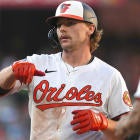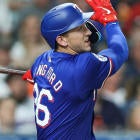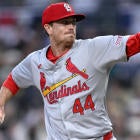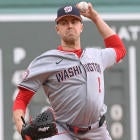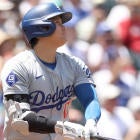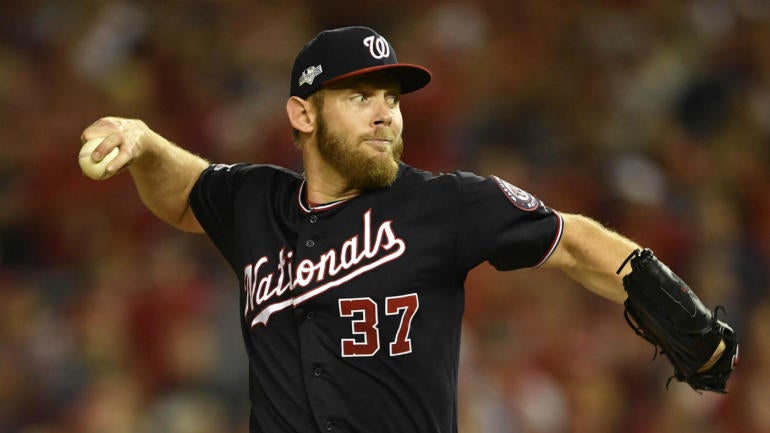
You need good starting pitching to compete in nearly every Fantasy baseball league. Nobody would deny this fact. At the end of the season, if you don't have multiple aces and several other good starters, you probably aren't going to be contending for a championship.
The question is always whether you need to invest in starting pitcher early to have the kind of pitching staff you need to compete at the end of the season. It's a debate as old as Fantasy baseball itself, but in recent years, the SP-heavy approach to drafting is starting to win the debate, with 32 starters being drafted inside the top 100 in NFC ADP in 2021 drafts. In 2017, that number was just 22, and even in 2020, it was just 25 starters inside the top 100. The most we've seen over the last five seasons is 27, in 2019.
And it's not just the middle class that's getting pushed up. There are 16 SPs being drafted inside the top 50 overall, up from 13 and 14 over the previous two seasons, and the ADP of the top 10 starters is up to 17.48 this season; it was 21.46 and 22.7 in 2020 and 2019, respectively. As you can see in the chart below, starting pitchers are going higher in drafts than any recent season across the board:
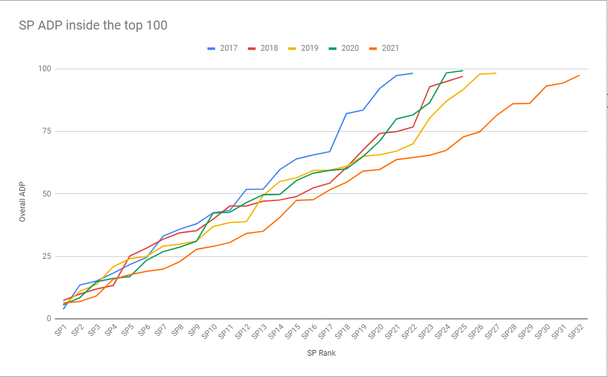
The wisdom of the crowds certainly suggests that you should be targeting starting pitcher early and often in your draft, to an extent we've never really seen before. But, as I wrote about in my starting pitcher preview, pitchers are a riskier early-round investment than hitters at pretty much every range of the draft, and investing heavily in them may not be the best idea. I'd like to expand on that a bit here by diving into some of the recent results from 2017 through 2020 a bit more.
First, let's take a look at what pitchers have been worth in each draft round of a 12-team league on average:
First round
In the time frame we're talking about, first-round pitchers have been uniformly excellent. Five pitchers have been selected in the first round a total of eight times over the four seasons covered, and all but two have finished among the top 50 overall players in Fantasy that season. The exceptions were Max Scherzer finishing 66th in 2019 with a 2.92 ERA, 1.03 WHIP and 243 strikeouts in 172.1 innings, and Clayton Kershaw finished 119th with a 2.73 ERA, 1.04 WHIP and 155 strikeouts in 161.1 innings. If you extrapolate the short-season stats from 2020 to a full-season, each first-round pitcher has thrown at least 158 innings, with an average of: 184 IP, 241 K, 14 W, 2.53 ERA and 0.96 WHIP. If you drafted a first-round pitcher, you've basically never had reason to be disappointed.
Second round
Things look quite different as soon as you get to the second round, with five pitchers out of 11 finishing outside of the top 100, including four outside of the top 200. However, that's pretty heavily skewed toward 2020, when Justin Verlander, Max Scherzer, Walker Buehler, and Jack Flaherty were all among the biggest disappointments at the position; from 2017 to 2019, second-round pitchers averaged a 3.08 ERA, 0.98 WHIP, 12 W, and 207 K in 163 innings, with six of seven finishing as top-20 players overall. Given how strange the 2020 season was, it's fair to chalk the struggles of that year's second-round crop up to bad luck and continue to assume second-round pitchers will, on the whole, continue to be very good investments.
Third round
It gets harder to defend the third-round pitchers. Of the 16 pitchers who have averaged a third-round pick over the last four seasons, only eight finished in the top 100 players that season, including just two out of eight over the last two seasons. And it's worth looking at what some of those big disappointments have looked like:
- 2020: Stephen Strasburg coming off one of the best seasons of his career (and a rare healthy campaign) and Mike Clevinger coming off a small-sample size breakout, with time missed due to injury
- 2019: Aaron Nola threw 200 innings but had some weird command issues that aren't totally fair to hold against him; Corey Kluber had an elite track record but was entering his age-33 season, while Blake Snell and Trevor Bauer were coming off outlier breakout seasons that pushed them way up draft boards.
You can kind of see what's happening here: The third round is where you start to see the more speculative pitchers get pushed to. If you've got a mulit-year track record of elite production and health, you're probably going to be going inside of the first two rounds -- the exceptions to that over the last four years were Walker Buehler and Jack Flaherty last season, both of whom busted. The third round is where the pitchers with question marks start to show up, whether they be injury or age-related, or just because they don't have a track record to back it up.
That's not to say you can't get big wins in this third-round range, of course; Shane Bieber and Gerrit Cole were the No. 1 pitchers in each of the last two seasons from this range. But you're already starting to see the hit rate drop below 50%.
Fourth round
You might want to avert your eyes if you are an advocate of early pitching because the fourth round is about to really let you down. Of the 13 starters drafted in the fourth round on average over the last four seasons, only three have finished as top-100 players that season, and only one finished in the top 50. Eight of the 13 finished outside of the top 200 overall. As a group, they averaged a 3.91 ERA and 1.27 WHIP with 171.8 K and 9.4 W in 153.8 innings. What might be most concerning about this track record is, these pitchers have, on average, been ranked between 9 and 12 in ADP among starters in their respective seasons; SP9-12 are currently going off the board inside of the top 35 picks in 2021 drafts.
Fifth round and beyond
Of course, there's nothing magical about a fourth-round ADP that makes it a death knell for a pitcher's Fantasy value, as the fifth-round range reminds us. There's a bit of a bounceback here, with 10 of 17 finishing in the top 100 that season. That rate dips to just five of 13 in the sixth round range, however, that still means that 16 of 30 starters drafted between the fifth and sixth rounds finished in the top 100 over the previous four seasons, compared to just 11 of 29 in the third through fourth.
We've seen fewer starters selected in the seventh and eighth round ranges, because that's when you often see closers come off the board, but they've been pretty bad investments themselves, with three of 13 finishing as top 100 players. And, while you would naturally expect players drafted closer to 100 overall to finish 100th or better less often, only one additional player even finished inside of the top 150.
All in all, your chances of drafting a top-50 player at starting pitcher are barely better than 50% once you get to the second round and pretty much crater beginning in the fourth round. You can see the rates for each round below:
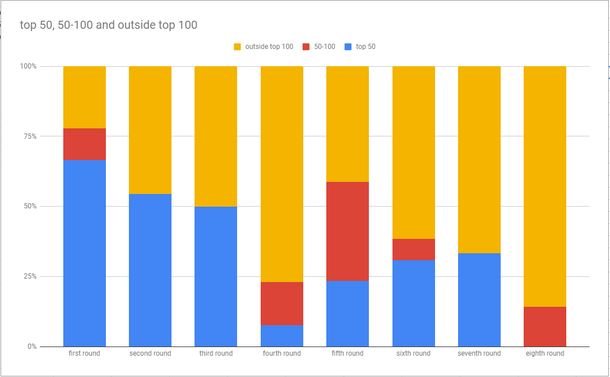
Clearly, there is value in drafting starting pitchers early, but that edge typically disappears right around the third round. At least over the last four seasons, the top eight or so starters in ADP were the only ones who had even a 50% chance of finishing as a top-50 player that season, and your chances of hitting on even a top-100 player were well below 50% from the fourth round on.
Of course, since the Fantasy community as a whole is a lot better about identifying which pitchers will hit the earlier they are drafted, maybe the fact that pitchers as a whole are being pushed up boards means we're better at identifying which pitchers will hit?
We're arguably getting worse at drafting SP
Unfortunately, that hasn't been the case in recent years. If anything, the track record for early-round pitchers has gotten demonstrably worse over the last few seasons:
2020 | 2019 | 2018 | 2017 | |
1st | 2/2 | 2/2 | 2/3 | 1/1 |
2nd | 0/4 | 1/2 | 1/1 | 4/4 |
3rd | 1/3 | 1/6 | 3/5 | 3/3 |
4th | 0/3 | 1/3 | 1/4 | 1/3 |
5th | 3/5 | 4/5 | 1/4 | 2/3 |
6th | 2/3 | 1/5 | 1/2 | 1/3 |
In 2020, just three of 12 pitchers drafted in the first four rounds finished as top-100 players; in 2019, it was just five of 13. In 2018 and 2017, it was seven out of 13 and nine out of 11.
We're dealing with pretty small sample sizes here, obviously, and especially with 2020, it's hard to take too much from a shortened season played under extreme circumstances. However, it's hard to justify the trend toward taking pitchers earlier than ever in 2021.
Especially given that short season in 2020. No pitcher threw more than Lance Lynn's 84 innings last season, so we're dealing with sample sizes around 2.5 times smaller than we're used to. But that hasn't stopped players from gaining or losing value, often considerably in one way or the direction.
What that means is, we're investing more in 2020 in a class of players who, even in the best of circumstances, have a hit rate around 50%, and we're doing it based on less information than ever before. Hitters have historically been much better investments at basically every range of the draft:
top-100 finish by draft range for H and P
— Chris Paul Towers (@CTowersCBS) February 16, 2021
Rounds 1-2: 81.8% vs. 57.1%
Rounds 3-4: 62.8% vs. 30.4%
Rounds 5-6: 43.5% vs. 54.5%
Rounds 7-8: 45.7% vs. 17.6%
And top 50:
Rounds 1-2: 63.6% vs. 50.0%
Rounds 3-4: 32.6% vs. 26.1%
Rounds 5-6: 28.3% vs. 27.3%
Rounds 7-8: 23.9% vs. 11.7%
It's hard to avoid an obvious conclusion in the face of all this: The new trend pushing pitchers up draft boards just doesn't make a lot of sense. You can argue that the high volatility of starting pitchers means you have to take more early so you can have more bites at the apple to end up with those difference makers you need at the end of the season. However, your early draft picks are your best chances to acquire high-end contributors during the whole season, and investing them in players who are unlikely to return a positive investment is a strategy that seems ripe for error.
This is one way in which it might make more sense than ever to zig when everyone else is zagging.









